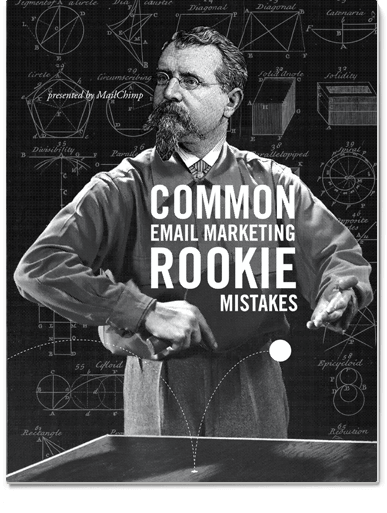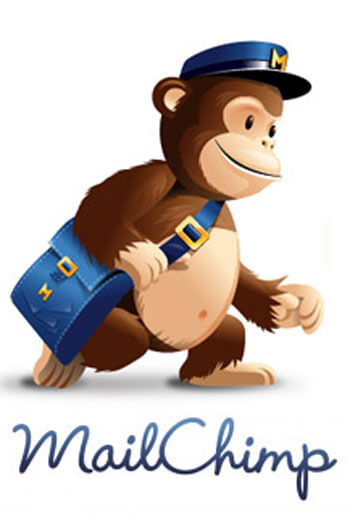 Whether you’re advising readers of your latest blog posts or announcing new book releases, sales, contests or other book promotions, there are right and wrong ways to engage your readers with emails. Here are seven great pointers – mistakes to avoid – from ace email marketing service, Mailchimp. Click on the title or image to read their entire “Common Rookie Mistakes” online or you can download a free pdf or digital edition:
Whether you’re advising readers of your latest blog posts or announcing new book releases, sales, contests or other book promotions, there are right and wrong ways to engage your readers with emails. Here are seven great pointers – mistakes to avoid – from ace email marketing service, Mailchimp. Click on the title or image to read their entire “Common Rookie Mistakes” online or you can download a free pdf or digital edition:
1. Not Having Permission
Before you can send any email-marketing material, you must have permission from recipients. Before investing your time and money in an email-marketing program, start getting permission from your readers. It’s easier than you think, and it’ll result in fewer spam complaints, better deliverability, decreased legal liability, and— most importantly—better open and click results.
2. Assuming People Want to Hear From You
Did everyone on your list specifically give you permission to email them? If not, then you’re just assuming they want to hear from you. Big mistake. They’re going to report you as a spammer.
This concept seems to confuse a lot of people. They say, “But I get emails all the time from people I’ve never heard of, and I appreciate it.” Know that it’s different if someone sends one email directly to you, with a sales pitch. But when that same person crosses the line and “blasts” a sales pitch to an entire list of people, it quickly becomes spam. If you have a list of readers that know you, but they haven’t exactly opted-in for newsletters from you, then send them personal, individual email invitations asking them to join your list.
3. Purchasing Email Lists
By now, everyone should know better than to buy a “totally legitimate list of 30 million opt-in emails” via some sketchy piece of spam they got. That’s pretty obvious, but there are still some vendors out there selling “opt-in” lists the old-fashioned way. They collect email addresses and ask members if they’d like to “receive special offers from third parties.” Then, they sell those email addresses to other people. It’s not technically illegal, but be wary of any groups that just want to give you a big list of emails. They should be doing the delivery for you, so their recipients will recognize the sender, and so you won’t get reported for spam.
4. Thinking ”Blast” Instead of “Relationship”
We cringe when someone asks us if we can help them “blast” an email out to people. For one, the word “blast” should only be used in reference to missiles and tanks. Not permission marketing. Secondly, when people say “blast,” it usually means they think email is just a way to shoot out a bunch of emails, whether people want to hear from them or not. Email is all about getting permission from readers, sending them stuff they want to read, and listening to their feedback.
5. Writing Like a Used-Car Salesman
Don’t use pushy sales copy, like “BUY NOW!!!!” or “LIMITED TIME OFFER!!!” in email. It’s obnoxious. Plus, spam filters will penalize you for using what they consider “spammy” content. Spam filters look at a long list of criteria to decide whether or not an email is junk. These items are almost always on their lists of spammy criteria:
- Going crazy with exclamation points!!!!!!
- USING ALL CAPS BECAUSE IT’S LIKE YELLING IN AN EMAIL OMG
- Coding sloppy HTML (usually from converting a Microsoft Word file to HTML)
- Coloring fonts bright red or green
- Using the word “test” in the subject line
- Creating an HTML email that’s nothing but one big image, with little or no text
6. Sending With a Personal Reply-To Address
Don’t use your “@yahoo.com” or “@aol.com” home email address. You have an author website, don’t you? (If not, you probably shouldn’t be sending any email campaigns yet.) Use your website’s domain, on which you probably already have emails accounts. Some people like setting up an additional newsletter@companydomain.com address for their emails. That works too.
7. Ignoring Campaign Reports
One of the benefits of email-marketing services like MailChimp is that you can measure results after every email campaign. It’s tremendously useful. Check your email stats after every single campaign you send. Look for trends. Make changes to campaigns to see if you can improve your open rates, click rates, and, most importantly, conversions (someone buying your book as a result of your email). Remember: Always be checking.
Have you tried email marketing yet? Share your experience!
MailChimp makes it easy to design exceptional email campaigns, share them on social networks, integrate with web services you already use, manage subscribers, and track your results. Where Writers Win is a Mailchimp client and fan (and the design team there isn’t just professional, they’re downright FUN to work with!).

